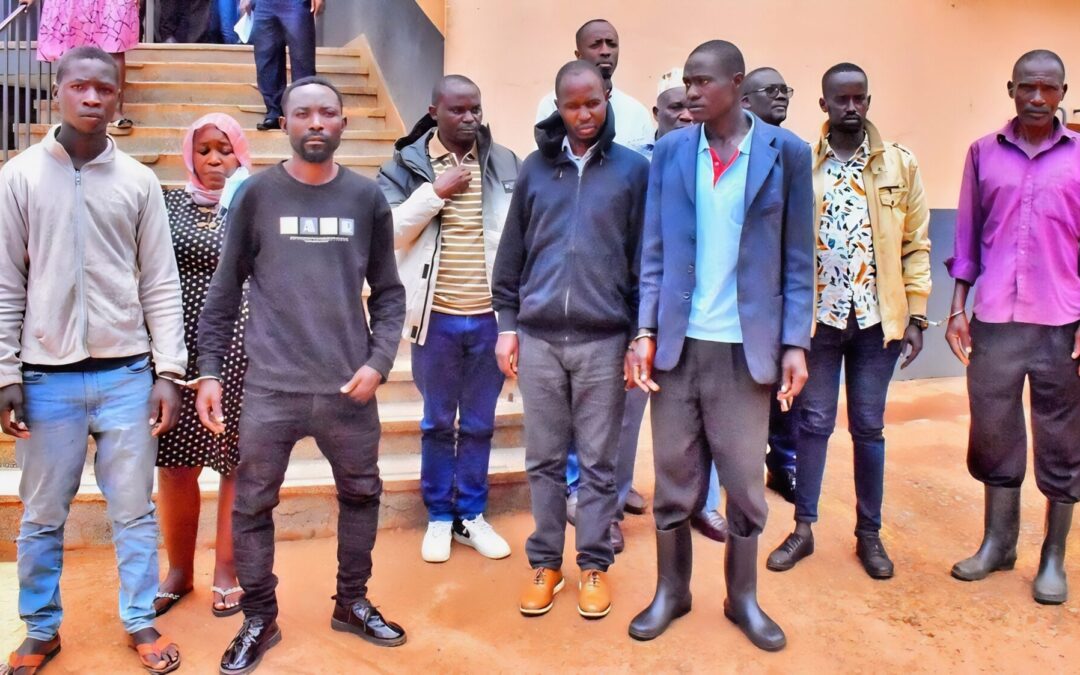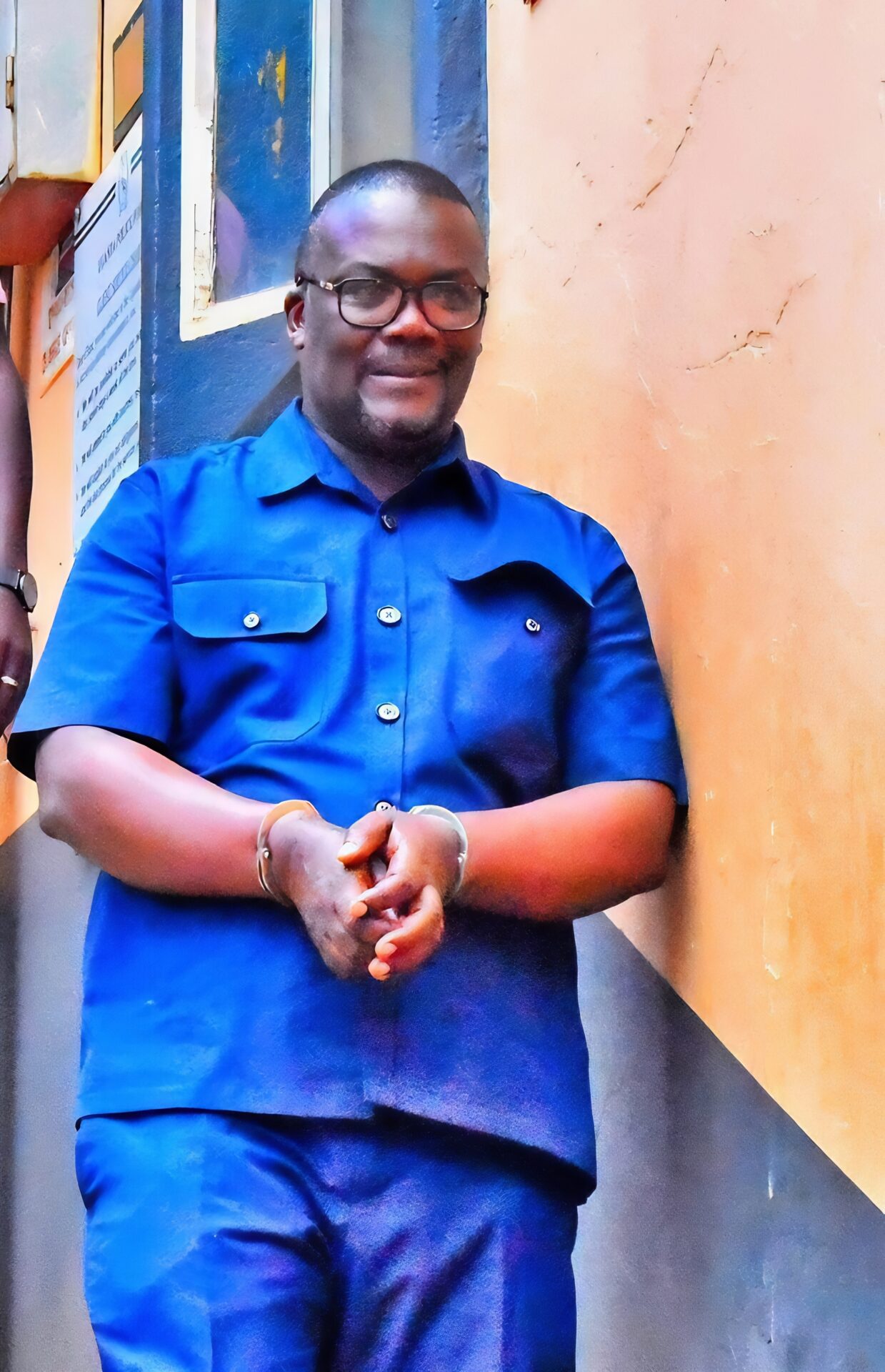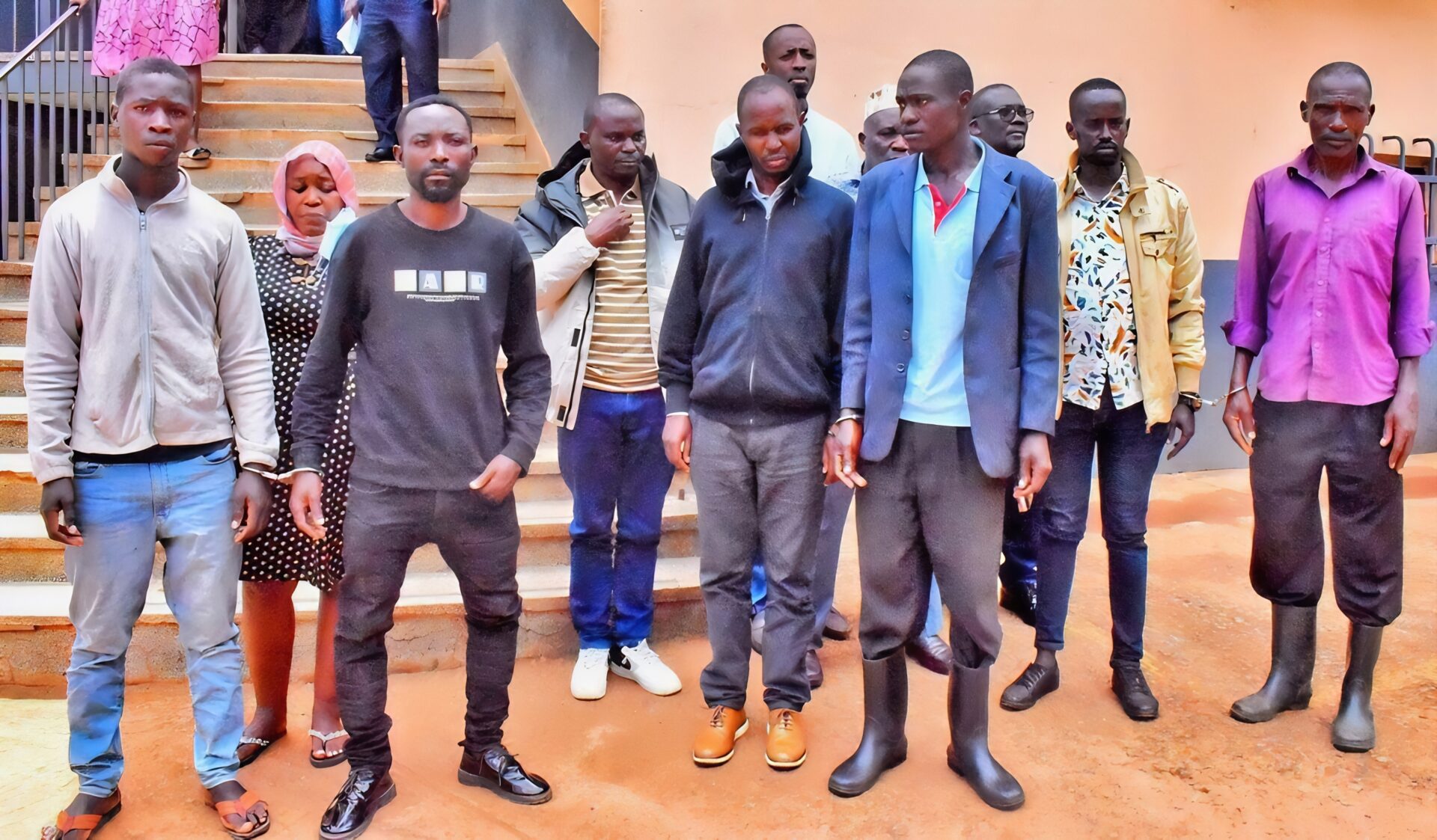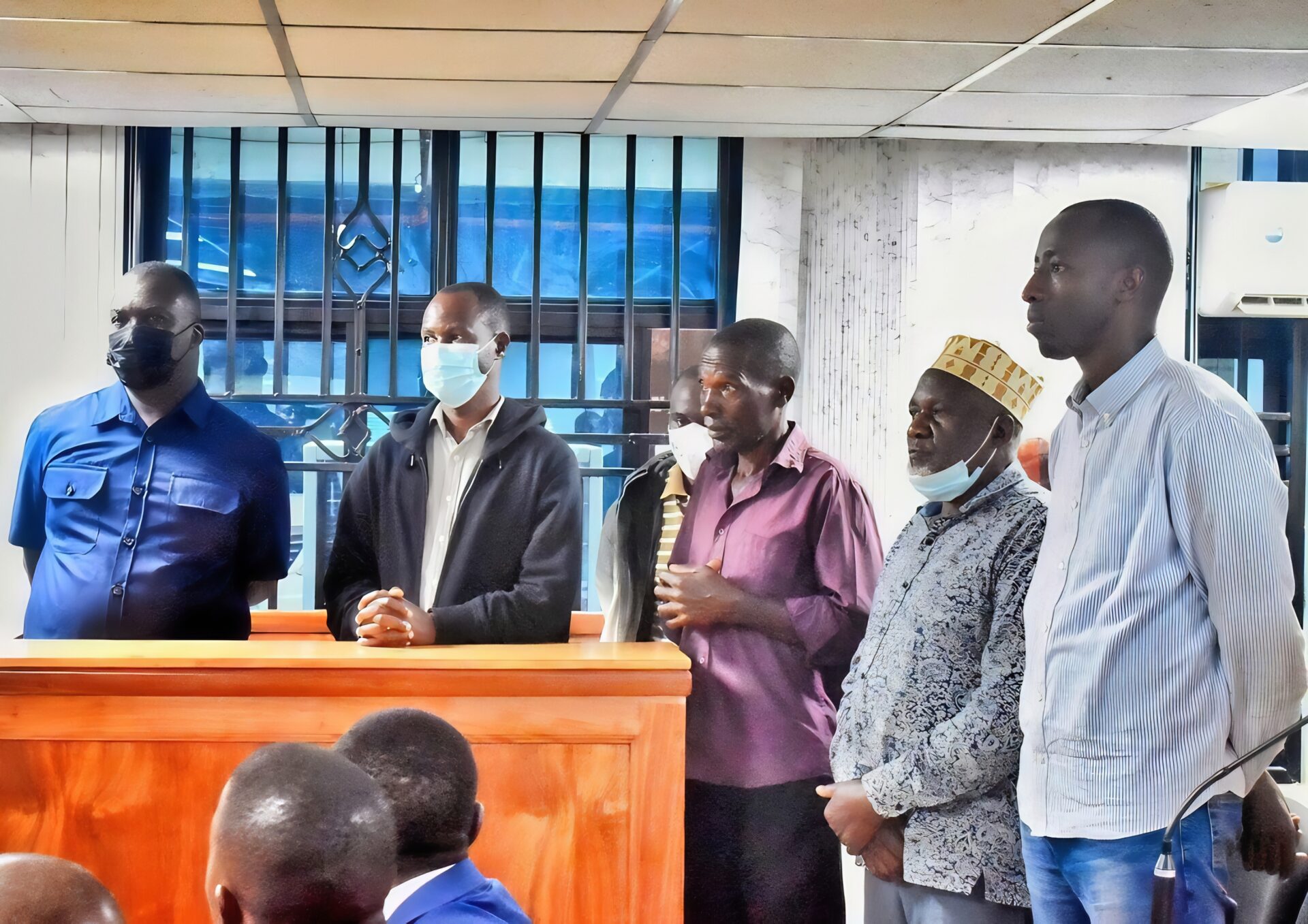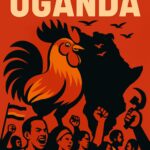From Chainsaws to Courtrooms: The Battle Against Corruption in Gomba District
In the lush hills of Uganda’s Gomba District, a sinister tale of corruption, environmental destruction, and resilience unfolds. At the heart of this saga lies FRV 60 folio 4, a prized parcel of land owned by Madhvani Group Ltd, which became the target of a brazen conspiracy led by Kakooza Jasper, Hajju Kayongo Badru Ismail, and other accomplices. Under the guise of a ‘boundary opening’ exercise, over 540 acres of natural forest and tea plantations were destroyed, leaving behind barren wastelands and shattered livelihoods. As eerie whispers and spectral legends emerged from the ruins, villagers like Nakato rose in defiance, supported by anti-graft agencies such as @AntiGraft_SH, @CID1_UG, and @ODPPUGANDA. This gripping story explores systemic failures in Uganda’s land governance, the devastating impact on biodiversity and climate resilience, and the ongoing fight for justice, accountability, and restoration. With fugitives still at large and reforms underway, the case serves as both a cautionary tale and a beacon of hope for equitable development and environmental stewardship in Uganda.
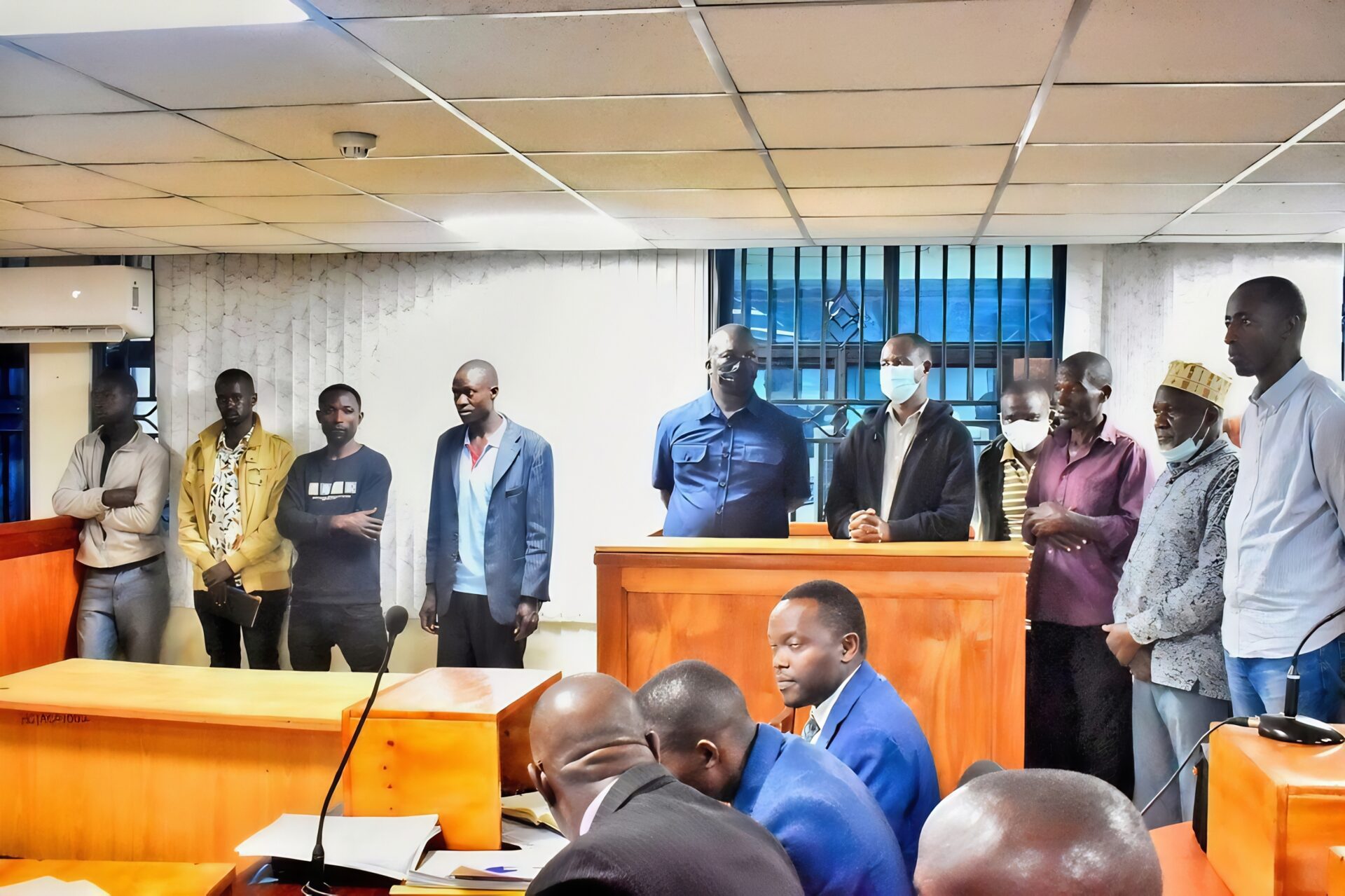
This case highlights a significant instance of alleged corruption and criminal activity involving high-ranking officials, local leaders, and private individuals in Uganda. The charges against the accused, including the Acting Commissioner for Mapping and Surveys at the Ministry of Lands, Kakooza Jasper, and nine others, reveal a complex scheme involving land fraud, abuse of office, forgery, and environmental destruction.
Key Details of the Case:
The Tea and Timber Conspiracy: A Tale of Greed, Ghosts, and Gomba
Prologue: The Soul of the Land
In the heart of Uganda’s Gomba District, where rolling hills cradle verdant tea plantations and ancient forests rise like sentinels against time, there lies a land steeped in history—and secrets. For centuries, these fertile soils have nurtured life: feeding families, sheltering wildlife, and sustaining ecosystems that stretch across East Africa. But beneath its beauty lies a vulnerability—a fragility that makes it ripe for exploitation.
This is not merely a tale of greed or corruption—it is an odyssey that weaves cruelty with satire, tragedy with whimsy, and conspiracy with fleeting moments of hope. It is a story about how human ambition can unravel even the most sacred bonds between people and their land.
Chapter 1: The Boundary Opening Charade
It all began innocuously enough. Kakooza Jasper, Acting Commissioner for Mapping and Surveys at the Ministry of Lands—a man whose name rolled off tongues like molasses—announced a routine “boundary opening” exercise. To the villagers of Musongole, this sounded harmless; after all, boundaries were lines drawn on maps, weren’t they? What harm could there be in clarifying them?
But Kakooza had other plans. With his neatly pressed suit and perpetually smug grin, he arrived flanked by a motley crew of accomplices: Bassajjangabo Hakim, the Senior Assistant Secretary (whose title was far grander than his actual competence); Ssenoga Abdu, a casual labourer with dreams bigger than his wallet; and Mudenyi Gerald, a security guard whose idea of authority involved flexing muscles rather than exercising intellect.
Together, these unlikely conspirators descended upon Madhvani Group Ltd’s sprawling estate, armed with forged documents, dubious intentions, and chainsaws sharp enough to fell centuries-old mahogany trees. Their mission? To carve out overlapping titles on FRV 60 folio 4—a piece of land registered since 1955—and sell it piecemeal to unsuspecting buyers or greedy businessmen like Nuwahereza Allan Katakanya, who saw profit in every fallen tree.
Chapter 2: The Ghosts of Mpenja Forest
As bulldozers rumbled through the once-pristine forest, strange things started happening. Locals reported hearing eerie whispers among the remaining trees, as if the spirits of the forest were mourning their loss. One night, Nabimanya David, another hapless security guard, swore he saw shadowy figures darting between the stumps, their eyes glowing like embers. He quit the next day, claiming he’d been cursed by the “ghosts of Mpenja.”
This added a touch of the fantastical to what was otherwise a brutally pragmatic operation. Yet no one laughed—not even when Kisenyi Harunah, the boda-boda rider hired to ferry supplies, crashed into a ditch while fleeing what he claimed was a spectral horse galloping across the road. In Gomba, superstition ran deep, and the locals whispered warnings: “You don’t steal from the earth without paying a price.”
Chapter 3: The Power Players
At the heart of the conspiracy sat two notable figures whose reputations would soon crumble under the weight of their greed. Hajju Kayongo Badru Ismail, the former Chairperson of the Gomba District Land Board, was a man known for his charm and cunning. He had convinced himself that bending rules was simply part of governance—an art form, really. His partner-in-crime, Nakanwagi Gladys, the erstwhile secretary of the same board, shared his amorality but lacked his finesse. Together, they orchestrated the bureaucratic gymnastics required to legitimise fraudulent titles.
Meanwhile, Siwuliliza Andrew Sserunkuma, the LC1 Chairman of Mpogo village, played the role of puppet master within the community. A charismatic leader with a penchant for theatrics, he rallied villagers to support the scheme by promising them jobs and payouts. But behind closed doors, he pocketed most of the proceeds, leaving only crumbs for those who trusted him.
And then there was Fred Kirenga, the businessman whose greed knew no bounds. Known locally as “The Timber Baron,” he saw the destruction of the forest as an opportunity to expand his lumber empire. His motto? “If it grows, it goes.” When warrants were issued for his arrest, he fled to Kampala, where he holed up in a luxury hotel, sipping whisky and pretending nothing was amiss.
Chapter 4: The Resistance
Not everyone in Gomba stood idly by. Among the villagers, a young woman named Nakato emerged as an unexpected hero. A teacher by profession and a poet by passion, she penned fiery verses decrying the destruction of her homeland. Her words spread like wildfire, igniting protests and drawing attention from anti-graft agencies.
“O forest, our mother,
They have stripped your skin,
Your roots scream in silence,
While thieves wear crowns of sin.”Her efforts caught the eye of @AntiGraft_SH, who worked tirelessly alongside @CID1_UG and @ODPPUGANDA to unravel the web of deceit. As arrests were made and evidence piled up, the accused found themselves cornered like rats in a trap.
Chapter 5: Justice—or Something Like It
The courtroom drama that followed was equal parts riveting and absurd. Kakooza Jasper, ever the performer, tried to charm the judge with tales of administrative errors gone awry. But his theatrics fell flat when CCTV footage surfaced showing him personally directing the felling of trees.
Hajju Kayongo attempted to shift blame onto his subordinates, but his former colleagues turned against him, revealing incriminating emails and voice notes. Even Ssenoga Abdu, the casual labourer, broke down in tears, admitting he’d only joined the scheme because he needed money to pay school fees for his children.
By the time the trial concluded, ten individuals had been sentenced to lengthy prison terms, while warrants remained active for others still at large. The land was returned to Madhvani Group Ltd, though scars—both literal and metaphorical—remained etched into the landscape.
Epilogue: Lessons from the Stumps
Months later, as Nakato walked through the remnants of Mpenja Forest, she couldn’t help but feel a mix of sorrow and hope. New saplings had been planted, their tender shoots reaching toward the sky. Children played among the stumps, oblivious to the battles fought over this soil.
In the distance, she heard laughter—the kind that comes from rebuilding, healing, and dreaming anew. And though the ghosts of Mpenja still lingered, their whispers now carried a different message: resilience endures, even in the face of greed.
Themes and Takeaways
- Corruption : The story highlights how systemic failures allow individuals to exploit power for personal gain, often at great cost to society.
- Environmentalism : The destruction of nature serves as a poignant reminder of humanity’s responsibility to protect the planet.
- Justice vs. Redemption : While legal consequences bring closure, true redemption lies in restoring what was lost—and learning from past mistakes.
- Community Resilience : Despite betrayal and hardship, ordinary people rise to challenge injustice, proving that collective action can triumph over tyranny.
Ultimately, The Tea and Timber Conspiracy is more than just a tale of crime and punishment. It’s a mirror reflecting the complexities of human nature: our capacity for both cruelty and compassion, destruction and renewal, despair and hope.
The Shadow Over Gomba: A Tale of Titles and Treachery
In the verdant hills of Gomba District, where the air carried the faint aroma of tea leaves drying in the sun and ancient forests whispered secrets older than Uganda itself, a sinister plot unfolded. It was not merely a tale of greed or corruption—it was an odyssey that wove cruelty with satire, tragedy with whimsy, and conspiracy with moments so heartwarming they almost made you forget the shadows lurking beneath.
Prologue: The Land Speaks
Long before colonial maps carved arbitrary lines across the soil, the land belonged to no one and everyone. Elders spoke of spirits dwelling in the roots of towering mahogany trees and rivers whose waters held memories of centuries past. But time moves swiftly, and by 1955, Madhvani Group Ltd had registered FRV 60 folio 4—a sprawling estate encompassing over 600 acres of fertile farmland and pristine forest. For decades, it thrived as a testament to industry and nature coexisting in harmony.
But harmony is fragile, especially when greed whispers its seductive promises.
Chapter 1: The Architects of Deceit
At the helm of this calamity stood Kakooza Jasper, Acting Commissioner for Mapping and Surveys at the Ministry of Lands—a man whose polished shoes squeaked louder than his conscience. To call him ambitious would be charitable; to call him ruthless would be accurate. With a penchant for bureaucratic jargon and an uncanny ability to manipulate red tape, he orchestrated the fraudulent creation of overlapping titles on Madhvani’s land.
His accomplices were a motley crew united by opportunism:
- Hajju Kayongo Badru Ismail, former Chairperson of the Gomba District Land Board, whose charm masked a Machiavellian mind.
- Nakanwagi Gladys, his secretary-turned-co-conspirator, who forged documents with the precision of a master artist.
- Bassajjangabo Hakim, Senior Assistant Secretary, whose title sounded grand but whose ethics were paper-thin.
- Siwuliliza Andrew Sserunkuma, LC1 Chairman of Mpogo village, who rallied villagers with false promises of prosperity while lining his own pockets.
- Nuwahereza Allan Katakanya, a businessman whose insatiable appetite for profit led him to fund much of the operation.
- And others—security guards, casual labourers, even a boda-boda rider—all cogs in a machine fuelled by corruption.
Together, they conspired to issue fake certificates of title, violently seize possession of the land, destroy its resources, and sell off parcels to unsuspecting buyers. Their actions amounted to nothing less than a declaration of war against both humanity and nature.
Chapter 2: The Crime Scene
Under the guise of a “boundary opening” exercise—a term as innocuous as it was deceptive—the conspirators descended upon Musongole village like locusts. Bulldozers roared to life, chainsaws screamed, and within days, centuries-old trees fell like dominos. Tea plantations, once vibrant green carpets stretching toward the horizon, were reduced to barren wastelands.
The destruction was not just economic—it was ecological. Over 540 acres of natural forest vanished, taking with them habitats for countless species. Rivers ran dry, their beds choked with debris. Villagers watched in stunned silence as their ancestral home transformed into a graveyard of stumps and ash.
And yet, amidst the devastation, strange occurrences began to unfold. Locals reported hearing eerie whispers emanating from the remaining trees, as if the spirits of the forest were mourning their loss. One night, Nabimanya David, a security guard tasked with guarding the site, swore he saw shadowy figures darting between the wreckage, their eyes glowing like embers. He fled the scene, claiming the land itself was cursed.
Chapter 3: The Resistance
Not all were complicit in this travesty. Among the villagers emerged Nakato, a young schoolteacher with a poet’s soul and a warrior’s spirit. Her verses became anthems of resistance, decrying the pillaging of her homeland:
“O earth, our mother,
They have stripped your skin,
Your roots scream in silence,
While thieves wear crowns of sin.”Her words ignited protests, drawing attention from anti-graft agencies like @AntiGraft_SH, @CID1_UG, and @ODPPUGANDA. These organizations worked tirelessly to uncover the truth, piecing together evidence that exposed the full extent of the conspiracy.
Meanwhile, rumours swirled about supernatural retribution. Some claimed to see ghostly apparitions haunting the ruins of the forest. Others spoke of crops failing wherever stolen land was resold. Whether these tales were born of fear or fact, they added a chilling layer to an already sinister saga.
Chapter 4: The Trial
When the accused finally faced justice, the courtroom became a stage for drama and absurdity. Kakooza Jasper, ever the performer, attempted to charm the judge with convoluted explanations of administrative errors. But his theatrics unravelled when CCTV footage surfaced showing him personally directing the felling of trees.
Hajju Kayongo tried to shift blame onto his subordinates, only for incriminating emails and voice notes to surface, courtesy of whistleblowers within the Land Board. Even Nuwahereza Allan Katakanya, the timber baron, broke down under cross-examination, admitting his role in funding the operation.
By the end of the trial, ten individuals had been sentenced to lengthy prison terms, while warrants remained active for others still at large. The land was returned to Madhvani Group Ltd, though scars—both literal and metaphorical—remained etched into the landscape.
Epilogue: Redemption Amidst Ruins
Months later, Nakato walked through the remnants of Mpenja Forest. Saplings had been planted, their tender shoots reaching toward the sky. Children played among the stumps, oblivious to the battles fought over this soil. In the distance, she heard laughter—the kind that comes from rebuilding, healing, and dreaming anew.
Yet, the ghosts of Mpenja still lingered. Their whispers now carried a different message: resilience endures, even in the face of greed.
Themes and Takeaways
- Abuse of Office : The story underscores how those entrusted with power can misuse it for personal gain, betraying public trust.
- Forgery and Fraud : Fake documents and overlapping titles symbolize the fragility of legal systems when corrupted by greed.
- Environmental Destruction : The annihilation of forests and plantations serves as a poignant reminder of humanity’s responsibility to protect the planet.
- Conspiracy : The collective planning and execution of crimes highlight the dangers of collusion and systemic failure.
- Justice vs. Redemption : While legal consequences bring closure, true redemption lies in restoring what was lost—and learning from past mistakes.
- Community Resilience : Despite betrayal and hardship, ordinary people rise to challenge injustice, proving that collective action can triumph over tyranny.
Ultimately, The Shadow Over Gomba is more than just a tale of crime and punishment. It’s a mirror reflecting the complexities of human nature: our capacity for both cruelty and compassion, destruction and renewal, despair and hope.
The Shadow of Musongole: A Tale of Greed, Ghosts, and Redemption
Prologue: The Land Speaks
In the verdant hills of Gomba District, where tea leaves glistened under the morning sun and ancient forests stood as sentinels of time, lay a treasure coveted by many. For over six decades, FRV 60 folio 4—a sprawling estate spanning more than 600 acres—had belonged to Madhvani Group Ltd., one of Uganda’s most iconic enterprises. This land was not merely an asset; it was a legacy, a testament to the harmony between industry and nature.
But legacies are fragile things, especially when greed whispers its seductive promises.
Chapter 1: The Intruders
It began with whispers among villagers in Musongole. Strangers arrived unannounced, their polished shoes and clipboard-clutching hands out of place amidst the mud-caked paths and thatched roofs. At their helm stood Kakooza Jasper, Acting Commissioner for Mapping and Surveys—a man whose smile could charm snakes but whose intentions were anything but benevolent.
Under the guise of a “boundary opening” exercise—a bureaucratic term so bland it almost sounded harmless—they claimed to be clarifying property lines. But those who knew the land well saw through the ruse. Elders muttered warnings about disturbing sacred soil, while farmers exchanged uneasy glances. Something sinister was brewing.
Behind Kakooza loomed accomplices:
- Hajju Kayongo Badru Ismail, former Chairperson of the Gomba District Land Board, whose charm masked a Machiavellian mind.
- Nakanwagi Gladys, his secretary-turned-forger, whose pen signed away justice for bribes.
- Siwuliliza Andrew Sserunkuma, LC1 Chairman of Mpogo village, whose charisma rallied villagers with false promises of prosperity.
- Nuwahereza Allan Katakanya, a timber baron whose insatiable appetite for profit drove much of the operation.
Together, they conspired to forge documents, issue overlapping titles, and violently seize control of Madhvani’s land. Their goal? To carve up the estate and sell it piecemeal to unsuspecting buyers or greedy businessmen eager to exploit its resources.
Chapter 2: Chainsaws and Shadows
As bulldozers roared into action and chainsaws screamed through the air, the once-pristine landscape transformed into a scene of devastation. Tea plantations, once vibrant green carpets stretching toward the horizon, were reduced to barren wastelands. Over 540 acres of natural forest vanished, taking with them habitats for countless species. Rivers ran dry, their beds choked with debris. The land wept silently, its scars visible to all who cared to look.
And then, strange things started happening. Villagers reported hearing eerie whispers emanating from the remaining trees, as if the spirits of the forest mourned their loss. One night, Nabimanya David, a security guard hired to protect the site, swore he saw shadowy figures darting between the wreckage, their eyes glowing like embers. He quit the next day, claiming the land itself was cursed.
Even Kisenyi Harunah, the boda-boda rider tasked with ferrying supplies, met misfortune when he crashed into a ditch while fleeing what he described as a spectral horse galloping across the road. Rumours spread quickly, blending fact with folklore, fear with fascination.
To some, these events were mere coincidence—but others believed the land had awakened, exacting vengeance upon those who violated it.
Chapter 3: Resistance Rising
Amidst the chaos emerged Nakato, a young schoolteacher whose voice carried both defiance and grace. Her poetry became a rallying cry for resistance:
“O motherland, your skin they tear,
Your roots scream loud, but none will hear.
Yet still you stand, though scarred and bare,
For truth shall bloom where shadows dare.”Her words ignited protests, drawing attention from anti-graft agencies like @AntiGraft_SH, @CID1_UG, and @ODPPUGANDA. Investigators uncovered forged documents, incriminating emails, and witness testimonies that painted a damning picture of collusion and corruption.
Meanwhile, local leaders like Chief Mukiibi—a wise elder known for his unwavering integrity—organized community meetings to reclaim stolen land. Together, they planted saplings in defiance of destruction, vowing to restore what had been lost.
Chapter 4: Justice—or Something Like It
When the accused finally faced trial, the courtroom became a stage for drama and absurdity. Kakooza Jasper, ever the performer, attempted to charm the judge with elaborate explanations of administrative errors. But his theatrics unravelled when CCTV footage surfaced showing him personally directing the felling of trees.
Hajju Kayongo tried to shift blame onto subordinates, only for incriminating emails to surface. Even Nuwahereza Allan Katakanya broke down under cross-examination, admitting his role in funding the operation.
By the end of the trial, ten individuals had been sentenced to lengthy prison terms, while warrants remained active for others still at large. The land was returned to Madhvani Group Ltd., though scars—both literal and metaphorical—remained etched into the landscape.
Epilogue: Healing the Wounds
Months later, Nakato walked through the remnants of Mpenja Forest. Saplings had taken root, their tender shoots reaching toward the sky. Children played among the stumps, oblivious to the battles fought over this soil. In the distance, she heard laughter—the kind that comes from rebuilding, healing, and dreaming anew.
Yet the ghosts of Mpenja still lingered. Their whispers now carried a different message: resilience endures, even in the face of greed.
Themes and Takeaways
- Victimhood and Resilience : Madhvani Group Ltd., a symbol of progress and heritage, becomes a victim of systemic corruption and greed. Yet, its story underscores resilience and the fight for justice.
- Environmental Degradation : The destruction of forests and plantations serves as a poignant reminder of humanity’s responsibility to protect ecosystems vital to survival.
- Corruption and Exploitation : Through forgery, fraudulent procurement of titles, and forcible entry, the narrative exposes how opportunists exploit resources for personal gain.
- Community Solidarity : Despite betrayal and hardship, ordinary people rise to challenge injustice, proving that collective action can triumph over tyranny.
- Hope Amid Despair : While the scars of greed run deep, the story ends on a hopeful note, emphasizing renewal and reconciliation.
Ultimately, The Shadow of Musongole transcends its Ugandan setting to become a universal parable about the clash between progress and preservation, greed and grace, darkness and light. It reminds us that while the wounds inflicted by human folly may heal slowly, the resilience of both nature and community ensures that life finds a way forward—even in the shadow of ruin.
The Ghosts of Gomba: A Chronicle of Fraud, Forests, and Fury
Prologue: The Year 2024 – When Shadows Fell
In the lush hills of Gomba District, where tea leaves danced in the breeze and ancient forests whispered secrets to those who dared listen, a dark chapter began. It was 2024—a year that would forever be etched into the memory of Musongole village. Beneath the veneer of progress lurked corruption so vile, so calculated, that it left scars on both the land and its people.
Under the guise of a routine “boundary opening,” a cabal of opportunists set out to steal what was not theirs. Their actions were cruel, their motives sinister, and their methods labyrinthine. Yet, as fate would have it, justice does not sleep forever—even in Uganda’s most shadowy corners.
Chapter 1: The Arrival of Kakooza Jasper
It all started innocuously enough—or so it seemed. In early 2024, Kakooza Jasper, Acting Commissioner for Mapping and Surveys at the Ministry of Lands, arrived in Musongole with an entourage of bureaucrats and hangers-on. Dressed in his trademark polished suit, he carried himself with an air of authority that bordered on arrogance. To the villagers, his presence felt ominous, though few could articulate why.

Kakooza announced a “boundary opening” exercise—an innocuous-sounding term meant to clarify property lines. But beneath this bureaucratic jargon lay a nefarious scheme. Working alongside him were accomplices whose names would later become infamous:
- Hajju Kayongo Badru Ismail, former Chairperson of the Gomba District Land Board, whose charm masked a Machiavellian mind.
- Nakanwagi Gladys, his secretary-turned-forger, whose pen signed away justice for bribes.
- Siwuliliza Andrew Sserunkuma, LC1 Chairman of Mpogo village, whose charisma rallied villagers with false promises of prosperity.
- Nuwahereza Allan Katakanya, a timber baron whose insatiable appetite for profit drove much of the operation.
Together, they conspired to forge documents, issue overlapping titles, and violently seize control of Madhvani Group Ltd.’s registered land—FRV 60 folio 4—a parcel rich with tea plantations and dense forest.
Chapter 2: Chainsaws and Whispers
By mid-2024, the once-pristine landscape had transformed into a scene of devastation. Bulldozers roared into action, chainsaws screamed through the air, and over 540 acres of natural forest fell victim to Nuwahereza’s insatiable greed. Tea plantations, once vibrant green carpets stretching toward the horizon, were reduced to barren wastelands.
And then, strange things started happening. Villagers reported hearing eerie whispers emanating from the remaining trees, as if the spirits of the forest mourned their loss. One night, Nabimanya David, a security guard hired to protect the site, swore he saw shadowy figures darting between the wreckage, their eyes glowing like embers. He quit the next day, claiming the land itself was cursed.
Even Kisenyi Harunah, the boda-boda rider tasked with ferrying supplies, met misfortune when he crashed into a ditch while fleeing what he described as a spectral horse galloping across the road. Rumours spread quickly, blending fact with folklore, fear with fascination.
To some, these events were mere coincidence—but others believed the land had awakened, exacting vengeance upon those who violated it.
Chapter 3: Resistance Rising
Amidst the chaos emerged Nakato, a young schoolteacher whose voice carried both defiance and grace. Her poetry became a rallying cry for resistance:
“O motherland, your skin they tear,
Your roots scream loud, but none will hear.
Yet still you stand, though scarred and bare,
For truth shall bloom where shadows dare.”
Her words ignited protests, drawing attention from anti-graft agencies like @AntiGraft_SH, @CID1_UG, and @ODPPUGANDA. Investigators uncovered forged documents, incriminating emails, and witness testimonies that painted a damning picture of collusion and corruption.
Meanwhile, local leaders like Chief Mukiibi—a wise elder known for his unwavering integrity—organized community meetings to reclaim stolen land. Together, they planted saplings in defiance of destruction, vowing to restore what had been lost.
Chapter 4: Arrests and Arraignments
By late 2024, arrests began. The accused were paraded before the courts, their faces plastered across newspapers and television screens. Kakooza Jasper, ever the performer, attempted to charm the judge with elaborate explanations of administrative errors. But his theatrics unravelled when CCTV footage surfaced showing him personally directing the felling of trees.
Hajju Kayongo tried to shift blame onto subordinates, only for incriminating emails to surface. Even Nuwahereza Allan Katakanya broke down under cross-examination, admitting his role in funding the operation.
Warrants were issued for additional suspects still at large, including Sitenda Nicodemus Mugalu (Deputy RDC Gomba), Mugenyi Vicent (physical planner), and Fred Kirenga (businessman). These fugitives went underground, their whereabouts unknown, adding another layer of suspense to the unfolding drama.
Epilogue: Healing the Wounds
Months later, Nakato walked through the remnants of Mpenja Forest. Saplings had taken root, their tender shoots reaching toward the sky. Children played among the stumps, oblivious to the battles fought over this soil. In the distance, she heard laughter—the kind that comes from rebuilding, healing, and dreaming anew.
Yet, the ghosts of Mpenja still lingered. Their whispers now carried a different message: resilience endures, even in the face of greed.
Themes and Takeaways
- Timeline of Corruption : The story spans 2024, highlighting how swiftly greed can unravel decades of harmony. The timeline underscores urgency—the need to act before irreparable damage is done.
- Justice Delayed but Not Denied : While arrests occurred months after the crimes, the narrative emphasizes that accountability eventually catches up with wrongdoers.
- Environmental Degradation : The destruction of forests and plantations serves as a poignant reminder of humanity’s responsibility to protect ecosystems vital to survival.
- Community Solidarity : Despite betrayal and hardship, ordinary people rise to challenge injustice, proving that collective action can triumph over tyranny.
- Hope Amid Despair : While the scars of greed run deep, the story ends on a hopeful note, emphasizing renewal and reconciliation.
Ultimately, The Ghosts of Gomba transcends its Ugandan setting to become a universal parable about the clash between progress and preservation, greed and grace, darkness and light. It reminds us that while the wounds inflicted by human folly may heal slowly, the resilience of both nature and community ensures that life finds a way forward—even in the shadow of ruin.
The Cursed Canopy: A Tale of Greed, Ghosts, and Gomba
Prologue: The Breath of the Forest
In the heart of Uganda’s Gomba District, where the hills roll like waves and the air is thick with the scent of tea leaves drying in the sun, lies a treasure that defies valuation. For centuries, the forests of Musongole village have been more than just trees—they are sanctuaries for biodiversity, guardians against climate chaos, and lifelines for communities whose survival depends on their bounty. Over 540 acres of this ancient canopy once stood tall, whispering secrets to those who dared listen.
But whispers can turn into screams when greed takes hold. And so it was in 2024—a year when chainsaws replaced birdsong, and corruption felled what nature had nurtured for millennia.
Chapter 1: The Boundary Opening Deception
It began innocently enough—or at least, that’s what Kakooza Jasper wanted everyone to believe. In early 2024, the Acting Commissioner for Mapping and Surveys arrived in Musongole with an entourage of bureaucrats and hangers-on. Dressed in his trademark polished suit, he spoke of “boundary openings,” a term as bland as porridge but laden with sinister intent.
To the villagers, Kakooza’s presence felt ominous, though few could articulate why. Behind him trailed accomplices:
- Hajju Kayongo Badru Ismail, former Chairperson of the Gomba District Land Board, whose charm masked a Machiavellian mind.
- Nakanwagi Gladys, his secretary-turned-forger, whose pen signed away justice for bribes.
- Siwuliliza Andrew Sserunkuma, LC1 Chairman of Mpogo village, whose charisma rallied villagers with false promises of prosperity.
- Nuwahereza Allan Katakanya , a timber baron whose insatiable appetite for profit drove much of the operation.
Together, they conspired to forge documents, issue overlapping titles, and violently seize control of Madhvani Group Ltd.’s registered land—FRV 60 folio 4—a parcel rich with tea plantations and dense forest.
Chapter 2: Chainsaws and Shadows
By mid-2024, the once-pristine landscape had transformed into a scene of devastation. Bulldozers roared into action, chainsaws screamed through the air, and over 540 acres of natural forest fell victim to Nuwahereza’s insatiable greed. Tea plantations, once vibrant green carpets stretching toward the horizon, were reduced to barren wastelands.
The environmental impact was catastrophic. Entire ecosystems collapsed overnight. Birds fled as a group, their songs silenced. Monkeys abandoned their treetop homes, wandering aimlessly through villages in search of shelter. Rivers ran dry, their beds choked with debris. Carbon sequestration—the invisible shield protecting the planet from climate chaos—was shattered, leaving the region more vulnerable to droughts and floods.
Local livelihoods crumbled alongside the trees. Farmers who relied on the microclimate created by the forest found their crops failing. Women who gathered firewood or medicinal plants now walked miles to find substitutes. Children played among the stumps, unaware that they were witnessing the end of an era.
And then, strange things started happening. Villagers reported hearing eerie whispers emanating from the remaining trees, as if the spirits of the forest mourned their loss. One night, Nabimanya David, a security guard hired to protect the site, swore he saw shadowy figures darting between the wreckage, their eyes glowing like embers. He quit the next day, claiming the land itself was cursed.
Even Kisenyi Harunah, the boda-boda rider tasked with ferrying supplies, met misfortune when he crashed into a ditch while fleeing what he described as a spectral horse galloping across the road. Rumours spread quickly, blending fact with folklore, fear with fascination.
To some, these events were mere coincidence—but others believed the land had awakened, exacting vengeance upon those who violated it.
Chapter 3: Resistance Rising
Amidst the chaos emerged Nakato, a young schoolteacher whose voice carried both defiance and grace. Her poetry became a rallying cry for resistance:
“O motherland, your skin they tear,
Your roots scream loud, but none will hear.
Yet still you stand, though scarred and bare,
For truth shall bloom where shadows dare.”Her words ignited protests, drawing attention from anti-graft agencies like @AntiGraft_SH, @CID1_UG, and @ODPPUGANDA. Investigators uncovered forged documents, incriminating emails, and witness testimonies that painted a damning picture of collusion and corruption.
Meanwhile, local leaders like Chief Mukiibi—a wise elder known for his unwavering integrity—organized community meetings to reclaim stolen land. Together, they planted saplings in defiance of destruction, vowing to restore what had been lost. Each seedling was a promise: a pledge to rebuild not just the forest, but the lives it sustained.
Chapter 4: Arrests and Arraignments
By late 2024, arrests began. The accused were paraded before the courts, their faces plastered across newspapers and television screens. Kakooza Jasper, ever the performer, attempted to charm the judge with elaborate explanations of administrative errors. But his theatrics unravelled when CCTV footage surfaced showing him personally directing the felling of trees.
Hajju Kayongo tried to shift blame onto subordinates, only for incriminating emails to surface. Even Nuwahereza Allan Katakanya broke down under cross-examination, admitting his role in funding the operation.

Warrants were issued for additional suspects still at large, including Sitenda Nicodemus Mugalu (Deputy RDC Gomba), Mugenyi Vicent (physical planner), and Fred Kirenga (businessman). These fugitives went underground, their whereabouts unknown, adding another layer of suspense to the unfolding drama.
Epilogue: Healing the Wounds
Months later, Nakato walked through the remnants of Mpenja Forest. Saplings had taken root, their tender shoots reaching toward the sky. Children played among the stumps, oblivious to the battles fought over this soil. In the distance, she heard laughter—the kind that comes from rebuilding, healing, and dreaming anew.
Yet, the ghosts of Mpenja still lingered. Their whispers now carried a different message: resilience endures, even in the face of greed.
The environmental scars would take decades to heal—if they ever fully did. But the act of planting new trees gave hope. It reminded the villagers that life finds a way, even in the shadow of ruin. And perhaps, one day, the breath of the forest would return.
Themes and Takeaways
- Environmental Devastation : The destruction of over 540 acres of forest and tea plantations highlights the devastating consequences of unchecked greed—not just for businesses like Madhvani Group Ltd., but for biodiversity, climate resilience, and local livelihoods.
- Interconnectedness : The story underscores how human actions ripple outward, affecting ecosystems, economies, and communities in profound ways.
- Community Solidarity : Despite betrayal and hardship, ordinary people rise to challenge injustice, proving that collective action can triumph over tyranny.
- Hope Amid Despair : While the scars of greed run deep, the story ends on a hopeful note, emphasizing renewal and reconciliation.
Ultimately, The Cursed Canopy transcends its Ugandan setting to become a universal parable about the clash between progress and preservation, greed and grace, darkness and light. It reminds us that while the wounds inflicted by human folly may heal slowly, the resilience of both nature and community ensures that life finds a way forward—even in the shadow of ruin.
The Cursed Canopy: A Tale of Greed, Ghosts, and Gomba
Prologue: The Breath of the Forest
In the heart of Uganda’s Gomba District, where the hills roll like waves and the air is thick with the scent of tea leaves drying in the sun, lies a treasure that defies valuation. For centuries, the forests of Musongole village have been more than just trees—they are sanctuaries for biodiversity, guardians against climate chaos, and lifelines for communities whose survival depends on their bounty. Over 540 acres of this ancient canopy once stood tall, whispering secrets to those who dared listen.
But whispers can turn into screams when greed takes hold. And so it was in 2024—a year when chainsaws replaced birdsong, and corruption felled what nature had nurtured for millennia.
Chapter 1: The Boundary Opening Deception
It began innocently enough—or at least, that’s what Kakooza Jasper wanted everyone to believe. In early 2024, the Acting Commissioner for Mapping and Surveys arrived in Musongole with an entourage of bureaucrats and hangers-on. Dressed in his trademark polished suit, he spoke of “boundary openings,” a term as bland as porridge but laden with sinister intent.
To the villagers, Kakooza’s presence felt ominous, though few could articulate why. Behind him trailed accomplices:
- Hajju Kayongo Badru Ismail, former Chairperson of the Gomba District Land Board, whose charm masked a Machiavellian mind.
- Nakanwagi Gladys, his secretary-turned-forger, whose pen signed away justice for bribes.
- Siwuliliza Andrew Sserunkuma, LC1 Chairman of Mpogo village, whose charisma rallied villagers with false promises of prosperity.
- Nuwahereza Allan Katakanya, a timber baron whose insatiable appetite for profit drove much of the operation.
Together, they conspired to forge documents, issue overlapping titles, and violently seize control of Madhvani Group Ltd.’s registered land—FRV 60 folio 4—a parcel rich with tea plantations and dense forest.
Chapter 2: Chainsaws and Shadows
By mid-2024, the once-pristine landscape had transformed into a scene of devastation. Bulldozers roared into action, chainsaws screamed through the air, and over 540 acres of natural forest fell victim to Nuwahereza’s insatiable greed. Tea plantations, once vibrant green carpets stretching toward the horizon, were reduced to barren wastelands.
The environmental impact was catastrophic. Entire ecosystems collapsed overnight. Birds fled en masse, their songs silenced. Monkeys abandoned their treetop homes, wandering aimlessly through villages searching for shelter. Rivers ran dry, their beds choked with debris. Carbon sequestration—the invisible shield protecting the planet from climate chaos—was shattered, leaving the region more vulnerable to droughts and floods.
Local livelihoods crumbled alongside the trees. Farmers who relied on the microclimate created by the forest found their crops failing. Women who gathered firewood or medicinal plants now walked miles to find substitutes. Children played among the stumps, unaware that they were witnessing the end of an era.
And then, strange things started happening. Villagers reported hearing eerie whispers emanating from the remaining trees, as if the spirits of the forest mourned their loss. One night, Nabimanya David, a security guard hired to protect the site, swore he saw shadowy figures darting between the wreckage, their eyes glowing like embers. He quit the next day, claiming the land itself was cursed.
Even Kisenyi Harunah, the boda-boda rider tasked with ferrying supplies, met misfortune when he crashed into a ditch while fleeing what he described as a spectral horse galloping across the road. Rumours spread quickly, blending fact with folklore, fear with fascination.
To some, these events were mere coincidence—but others believed the land had awakened, exacting vengeance upon those who violated it.
Chapter 3: Resistance Rising
Amidst the chaos emerged Nakato, a young schoolteacher whose voice carried both defiance and grace. Her poetry became a rallying cry for resistance:
“O motherland, your skin they tear,
Your roots scream loud, but none will hear.
Yet still you stand, though scarred and bare,
For truth shall bloom where shadows dare.”
Her words ignited protests, drawing attention from anti-graft agencies like @AntiGraft_SH, @CID1_UG, and @ODPPUGANDA. Investigators uncovered forged documents, incriminating emails, and witness testimonies that painted a damning picture of collusion and corruption.
Meanwhile, local leaders like Chief Mukiibi—a wise elder known for his unwavering integrity—organized community meetings to reclaim stolen land. Together, they planted saplings in defiance of destruction, vowing to restore what had been lost. Each seedling was a promise: a pledge to rebuild not just the forest, but the lives it sustained.
Chapter 4: Arrests and Arraignments
By late 2024, arrests began. The accused were paraded before the courts, their faces plastered across newspapers and television screens. Kakooza Jasper, ever the performer, attempted to charm the judge with elaborate explanations of administrative errors. But his theatrics unraveled when CCTV footage surfaced showing him personally directing the felling of trees.
Hajju Kayongo tried to shift blame onto subordinates, only for incriminating emails to surface. Even Nuwahereza Allan Katakanya broke down under cross-examination, admitting his role in funding the operation.
Warrants were issued for additional suspects still at large, including Sitenda Nicodemus Mugalu (Deputy RDC Gomba), Mugenyi Vicent (physical planner), and Fred Kirenga (businessman). These fugitives went underground, their whereabouts unknown, adding another layer of suspense to the unfolding drama.
Epilogue: Healing the Wounds
Months later, Nakato walked through the remnants of Mpenja Forest. Saplings had taken root, their tender shoots reaching toward the sky. Children played among the stumps, oblivious to the battles fought over this soil. In the distance, she heard laughter—the kind that comes from rebuilding, healing, and dreaming anew.
Yet the ghosts of Mpenja still lingered. Their whispers now carried a different message: resilience endures, even in the face of greed.
The environmental scars would take decades to heal—if they ever fully did. But the act of planting new trees gave hope. It reminded the villagers that life finds a way, even in the shadow of ruin. And perhaps, one day, the breath of the forest would return.
Themes and Takeaways
- Environmental Devastation : The destruction of over 540 acres of forest and tea plantations highlights the devastating consequences of unchecked greed—not just for businesses like Madhvani Group Ltd., but for biodiversity, climate resilience, and local livelihoods.
- Interconnectedness : The story underscores how human actions ripple outward, affecting ecosystems, economies, and communities in profound ways.
- Community Solidarity : Despite betrayal and hardship, ordinary people rise to challenge injustice, proving that collective action can triumph over tyranny.
- Hope Amid Despair : While the scars of greed run deep, the story ends on a hopeful note, emphasizing renewal and reconciliation.
Ultimately, The Cursed Canopy transcends its Ugandan setting to become a universal parable about the clash between progress and preservation, greed and grace, darkness and light. It reminds us that while the wounds inflicted by human folly may heal slowly, the resilience of both nature and community ensures that life finds a way forward—even in the shadow of ruin.
The Shadow of Justice: A Tale of Trials, Treachery, and Time
Prologue: The Clock Strikes Midnight
In the humid corridors of Uganda’s Anti-Corruption Court, time seemed to stretch endlessly. For the accused—Kakooza Jasper, Hajju Kayongo Badru Ismail, Nakanwagi Gladys, and their motley crew—the calendar had become a prison in itself. Remanded until April 30, 2025, they faced not only the weight of their crimes but also the suffocating uncertainty of legal proceedings that dragged on like an unending rainy season.
Meanwhile, others remained elusive—ghosts haunting the edges of justice. Warrants for Sitenda Nicodemus Mugalu (Deputy RDC Gomba), Mugenyi Vicent (physical planner), and Fred Kirenga (businessman) dangled precariously over their heads, reminders of sins yet unpunished. Their absence cast long shadows across the courtroom, where truth and lies intertwined in a dance as old as humanity itself.
This is not merely a tale of law and order—it is a saga of power, betrayal, and redemption set against the backdrop of Gomba District’s scarred hills.
Chapter 1: The Accused
By early 2024, the conspirators thought themselves untouchable. Kakooza Jasper, Acting Commissioner for Mapping and Surveys, strutted through Musongole village with all the arrogance of a colonial governor. His accomplices followed suit:
- Hajju Kayongo Badru Ismail, former Chairperson of the Gomba District Land Board, whose charm could charm snakes but whose mind schemed like a spider weaving its web.
- Nakanwagi Gladys, his secretary-turned-forger, whose pen signed away centuries of tradition for quick cash.
- Siwuliliza Andrew Sserunkuma, LC1 Chairman of Mpogo village, whose charisma rallied villagers with false promises of prosperity.
- Nuwahereza Allan Katakanya, a timber baron whose insatiable greed drove much of the operation.
Together, they conspired to forge documents, issue overlapping titles, and violently seize control of Madhvani Group Ltd.’s registered land—FRV 60 folio 4—a parcel rich with tea plantations and dense forest.
But by late 2024, the tide turned. Arrests were made, and trials began. The accused found themselves remanded until April 30, 2025—a date etched ominously into their futures.
Chapter 2: The Missing Pieces
Not everyone was caught in the dragnet. Key figures still roamed free, slipping through cracks in the system like thieves under cover of darkness. Among them:
- Sitenda Nicodemus Mugalu, Deputy RDC Gomba, whose official title masked a role far more sinister. Rumours placed him at secret meetings where plans were hatched, though no one dared testify openly.
- Mugenyi Vicent, physical planner, whose blueprints disguised theft as development. He vanished shortly after warrants were issued, leaving behind whispers of offshore accounts and hidden properties.
- Fred Kirenga, businessman extraordinaire, whose name became synonymous with exploitation. Known locally as “The Timber Baron,” he fled Kampala, holing up in luxury hotels while claiming innocence via intermediaries.
Their evasion added layers of intrigue to an already labyrinthine case. Were they truly innocent scapegoats, or masterminds pulling strings from afar? Only time—and perhaps confessions—would tell.
Chapter 3: The Trial
When the trial finally commenced, it played out like a theatrical production. Each day brought new twists, revelations, and moments of sheer absurdity.
Kakooza Jasper, ever the performer, attempted to charm the judge with elaborate explanations of administrative errors. But his theatrics unravelled when CCTV footage surfaced showing him personally directing the felling of trees. His polished shoes squeaked loudly as he shuffled back to his seat, defeated.

Hajju Kayongo tried to shift blame onto subordinates, only for incriminating emails to surface. One email read: “Proceed with caution, but ensure the titles are ready by next week.” It was signed with his initials. The courtroom erupted in murmurs.
Even Nuwahereza Allan Katakanya broke down under cross-examination, admitting his role in funding the operation. Tears streamed down his face as he confessed, “I only wanted to make money—I didn’t think about the consequences.”
Yet, despite these admissions, the case remained complex. Lawyers argued over jurisdiction, evidence authenticity, and procedural technicalities. Witnesses recanted statements, fearing retaliation. And always, there loomed the spectre of those still at large—Sitenda, Mugenyi, and Fred—whose names hung heavy in the air like storm clouds.
Chapter 4: Whispers of Redemption
Outside the courtroom, life continued. Villagers planted saplings in defiance of destruction, vowing to restore what had been lost. Nakato, the young schoolteacher whose poetry had inspired resistance, led efforts to rehabilitate the forest. Children joined her, carrying buckets of water to nurture tender shoots reaching toward the sky.
One evening, as Nakato walked among the stumps, she heard laughter—the kind that comes from rebuilding, healing, and dreaming anew. Yet, the ghosts of Mpenja still lingered. Their whispers now carried a different message: resilience endures, even in the face of greed.
Epilogue: The Final Verdict
On April 30, 2025, the court delivered its verdict. Ten individuals were sentenced to lengthy prison terms, including Kakooza Jasper, Hajju Kayongo, and Nakanwagi Gladys. Their faces fell as the gavel struck, sealing their fates.
Still missing were Sitenda Nicodemus Mugalu, Mugenyi Vicent, and Fred Kirenga. Their warrants remained active, a reminder that justice is often incomplete. But hope persisted. Investigators vowed to pursue them relentlessly, wherever they hid.
Back in Musongole, the forest slowly began to heal. Birds returned, their songs mingling with the rustle of leaves. Rivers flowed again, nourishing fields once barren. Life found a way forward—even in the shadow of ruin.
Themes and Takeaways
- Legal Complexity : The prolonged remand period underscores the intricacies of corruption cases, where evidence collection and witness protection pose significant challenges.
- Elusive Justice : The fugitives’ evasion highlights systemic gaps, reminding us that accountability requires persistence and vigilance.
- Community Resilience : Despite setbacks, ordinary people rise to challenge injustice, proving that collective action can triumph over tyranny.
- Hope Amid Despair : While the scars of greed run deep, the story ends on a hopeful note, emphasizing renewal and reconciliation.
Ultimately, The Shadow of Justice transcends its Ugandan setting to become a universal parable about the pursuit of truth and fairness. It reminds us that while justice may sometimes feel distant, resilience ensures that it remains within reach—even in the darkest of times.
The Land Beneath the Lies: A Chronicle of Corruption, Courage, and Change
Prologue: The Soul of Uganda
In the verdant hills of Gomba District, where tea leaves shimmer in the sun and ancient forests stand as guardians of history, lies a land steeped in promise—and peril. For centuries, these fertile soils have nurtured life, feeding families, sheltering wildlife, and sustaining ecosystems that stretch across East Africa. But beneath its beauty lies a vulnerability—a fragility that makes it ripe for exploitation.
This is not merely a tale of greed or corruption—it is an odyssey that weaves cruelty with satire, tragedy with whimsy, and conspiracy with fleeting moments of hope. It is a story about how human ambition can unravel even the most sacred bonds between people and their land.
Chapter 1: Shadows on Sacred Ground
By early 2024, whispers began to ripple through Musongole village. Strangers arrived unannounced—men in polished shoes carrying clipboards, women in sharp blazers clutching folders. At their helm stood Kakooza Jasper, Acting Commissioner for Mapping and Surveys at the Ministry of Lands. To the villagers, his presence felt ominous, though few could articulate why.
Kakooza announced a “boundary opening” exercise—an innocuous-sounding term meant to clarify property lines. But beneath this bureaucratic jargon lay a nefarious scheme. Working alongside him were accomplices:
- Hajju Kayongo Badru Ismail, former Chairperson of the Gomba District Land Board, whose charm masked a Machiavellian mind.
- Nakanwagi Gladys, his secretary-turned-forger, whose pen signed away justice for bribes.
- Siwuliliza Andrew Sserunkuma, LC1 Chairman of Mpogo village, whose charisma rallied villagers with false promises of prosperity.
- Nuwahereza Allan Katakanya, a timber baron whose insatiable appetite for profit drove much of the operation.
Together, they conspired to forge documents, issue overlapping titles, and violently seize control of Madhvani Group Ltd.’s registered land—FRV 60 folio 4—a parcel rich with tea plantations and dense forest.
Chapter 2: Chainsaws and Whispers
By mid-2024, the once-pristine landscape had transformed into a scene of devastation. Bulldozers roared into action, chainsaws screamed through the air, and over 540 acres of natural forest fell victim to Nuwahereza’s insatiable greed. Tea plantations, once vibrant green carpets stretching toward the horizon, were reduced to barren wastelands.
And then, strange things started happening. Villagers reported hearing eerie whispers emanating from the remaining trees, as if the spirits of the forest mourned their loss. One night, Nabimanya David, a security guard hired to protect the site, swore he saw shadowy figures darting between the wreckage, their eyes glowing like embers. He quit the next day, claiming the land itself was cursed.
Even Kisenyi Harunah, the boda-boda rider tasked with ferrying supplies, met misfortune when he crashed into a ditch while fleeing what he described as a spectral horse galloping across the road. Rumours spread quickly, blending fact with folklore, fear with fascination.
To some, these events were mere coincidence—but others believed the land had awakened, exacting vengeance upon those who violated it.
Chapter 3: Resistance Rising
Amidst the chaos emerged Nakato, a young schoolteacher whose voice carried both defiance and grace. Her poetry became a rallying cry for resistance:
“O motherland, your skin they tear,
Your roots scream loud, but none will hear.
Yet still you stand, though scarred and bare,
For truth shall bloom where shadows dare.”
Her words ignited protests, drawing attention from anti-graft agencies like @AntiGraft_SH, @CID1_UG, and @ODPPUGANDA. Investigators uncovered forged documents, incriminating emails, and witness testimonies that painted a damning picture of collusion and corruption.
Meanwhile, local leaders like Chief Mukiibi—a wise elder known for his unwavering integrity—organized community meetings to reclaim stolen land. Together, they planted saplings in defiance of destruction, vowing to restore what had been lost.
Chapter 4: The Trial of the Century
When the accused finally faced trial, the courtroom became a stage for drama and absurdity. Kakooza Jasper, ever the performer, attempted to charm the judge with elaborate explanations of administrative errors. But his theatrics unravelled when CCTV footage surfaced showing him personally directing the felling of trees.
Hajju Kayongo tried to shift blame onto subordinates, only for incriminating emails to surface. Even Nuwahereza Allan Katakanya broke down under cross-examination, admitting his role in funding the operation.
Warrants were issued for additional suspects still at large, including Sitenda Nicodemus Mugalu (Deputy RDC Gomba), Mugenyi Vicent (physical planner), and Fred Kirenga (businessman). These fugitives went underground, their whereabouts unknown, adding another layer of suspense to the unfolding drama.
Epilogue: Healing the Wounds
Months later, Nakato walked through the remnants of Mpenja Forest. Saplings had taken root, their tender shoots reaching toward the sky. Children played among the stumps, oblivious to the battles fought over this soil. In the distance, she heard laughter—the kind that comes from rebuilding, healing, and dreaming anew.
Yet, the ghosts of Mpenja still lingered. Their whispers now carried a different message: resilience endures, even in the face of greed.
Broader Implications
Corruption in Land Administration
The case underscores persistent challenges in Uganda’s land governance systems, where corrupt practices by officials and collusion with private actors undermine legitimate ownership rights and public trust. The fraudulent creation of overlapping titles highlights systemic failures that allow opportunists to exploit resources for personal gain.
Environmental Degradation
The destruction of natural forests and agricultural land is alarming, as it exacerbates deforestation, habitat loss, and food security concerns. Such actions contradict national and global efforts to combat climate change and preserve ecosystems. Over 540 acres of forest vanished, leaving scars visible to all who cared to look.
Rule of Law
The swift action by anti-graft agencies (@AntiGraft_SH, @CID1_UG, and @ODPPUGANDA) demonstrates a commitment to enforcing accountability and justice. However, the involvement of high-level officials raises questions about institutional integrity and oversight mechanisms. Can institutions truly reform themselves, or will they perpetuate cycles of corruption?
Public Sentiment
Cases like this evoke strong reactions from citizens who view land-related corruption as a major barrier to equitable development. Public confidence in government institutions depends heavily on how such cases are resolved. Will justice prevail, or will cynicism deepen?
Themes and Takeaways
- Systemic Failure : The story exposes how weak governance enables corruption, undermining public trust and equitable development.
- Environmental Stewardship : The destruction of forests and plantations serves as a poignant reminder of humanity’s responsibility to protect ecosystems vital to survival.
- Accountability vs. Impunity : While arrests and trials demonstrate progress, the fugitives’ evasion underscores gaps in enforcement and oversight.
- Hope Amid Despair : While the scars of greed run deep, the story ends on a hopeful note, emphasizing renewal and reconciliation.
Ultimately, The Land Beneath the Lies transcends its Ugandan setting to become a universal parable about the clash between progress and preservation, greed and grace, darkness and light. It reminds us that while the wounds inflicted by human folly may heal slowly, the resilience of both nature and community ensures that life finds a way forward—even in the shadow of ruin.
The Roots of Redemption: A Tale of Justice, Restoration, and Renewal
Prologue: The Land Speaks
In the rolling hills of Gomba District, where tea leaves glisten in the morning sun and ancient forests whisper secrets to those who dare listen, lies a land scarred by greed—but also one poised for redemption. This is not merely a story of destruction; it is an odyssey of resilience, accountability, and hope. It is about how, even after the darkest storms, life finds a way forward.
Chapter 1: The Long Arm of Justice
By late 2024, the wheels of justice had begun to turn, albeit slowly. Kakooza Jasper, Hajju Kayongo Badru Ismail, Nakanwagi Gladys, and their accomplices sat behind bars, awaiting trial. Yet, authorities knew that true justice required more than locking up the obvious culprits—it demanded transparency, thoroughness, and unwavering resolve.
For weeks, investigators from @AntiGraft_SH, @CID1_UG, and @ODPPUGANDA combed through documents, cross-referenced testimonies, and traced financial transactions. Their work was painstaking but necessary. Every forged title deed, every bribe exchanged, every chain saw purchase—no detail was too small to escape scrutiny.
But challenges remained. Key figures like Sitenda Nicodemus Mugalu (Deputy RDC Gomba), Mugenyi Vicent (physical planner), and Fred Kirenga (businessman) remained at large, slipping through cracks in the system like ghosts. Authorities vowed to leave no stone unturned. Interpol alerts were issued, bank accounts frozen, and informants cultivated. The message was clear: there would be no safe haven for corruption.
Transparency became paramount. Investigators held regular press briefings, sharing updates with the public while ensuring confidentiality for whistleblowers. Community members, once wary of speaking out, began stepping forward, emboldened by the promise of accountability. For the first time in years, people dared to believe that justice might prevail.
Chapter 2: Restitution for Madhvani Group Ltd
As legal proceedings unfolded, attention turned to restitution. Madhvani Group Ltd., whose legacy had been tarnished by greed, deserved compensation—not just monetary but symbolic. Lawyers argued that beyond fines and penalties, the accused should fund the restoration of what they had destroyed.
The court agreed. A trust fund was established, pooling assets seized from the conspirators to finance environmental rehabilitation efforts. Additionally, Madhvani Group Ltd.’s rightful ownership of FRV 60 folio 4 was reaffirmed, with new digital safeguards implemented to prevent future fraud. Titles were reissued using blockchain technology, ensuring immutability and transparency.
Yet money alone could not mend the wounds inflicted. The group’s leaders visited Musongole village, meeting with farmers and elders to express gratitude for their resistance. Together, they planted ceremonial trees on the edge of the forest—a gesture symbolizing unity and renewal.
Chapter 3: Strengthening Land Governance
The case laid bare the vulnerabilities in Uganda’s land administration systems. To prevent similar schemes, sweeping reforms were proposed:
- Digitization : All land records would be digitized and stored on secure servers accessible only to authorized personnel. Blockchain technology would ensure tamper-proof documentation.
- Stricter Verification Protocols : Multi-layered approval processes were introduced, requiring independent audits before any title issuance or boundary adjustment.
- Community Oversight Committees : Local councils were empowered to oversee land transactions, acting as watchdogs against corruption.
- Whistleblower Protection Laws : New legislation shielded informants from retaliation, encouraging citizens to report suspicious activities without fear.
These measures sought not only to deter future crimes but also to restore public confidence in governance. For too long, land disputes had fuelled mistrust between communities and authorities. Now, there was hope for reconciliation.
Chapter 4: Replanting the Forest
Rehabilitating over 540 acres of destroyed forest was no small feat. Led by Nakato—the young schoolteacher whose poetry had inspired resistance—a coalition of villagers, NGOs, and government agencies embarked on a massive replanting initiative. Seedlings were sourced from nurseries across Uganda, each one representing a promise to rebuild.
Children joined the effort, carrying buckets of water to nurture tender shoots reaching toward the sky. Elders shared stories of the forest’s history, teaching younger generations its value. Slowly but surely, life returned to the barren landscape. Birds nested again among the branches, and rivers flowed freely once more.
Environmental experts monitored progress closely, documenting increases in biodiversity and carbon sequestration. They estimated it would take decades for the forest to fully recover—but every sapling planted marked a step toward healing.
Chapter 5: Accountability and Deterrence
When the final verdict was delivered in April 2025, it sent shockwaves through Uganda. Ten individuals were sentenced to lengthy prison terms, including Kakooza Jasper and Hajju Kayongo. Fines totalling millions of shillings were imposed, with proceeds directed toward the rehabilitation fund.
For Sitenda Nicodemus Mugalu, Mugenyi Vicent, and Fred Kirenga, capture remained elusive—but the net tightened daily. Authorities left no doubt: these fugitives would face justice eventually. Their names became cautionary tales, whispered warnings to others tempted by greed.
Penalties extended beyond imprisonment. Public shaming campaigns highlighted the accused’s crimes, stripping them of social standing. Businesses implicated in the scheme were blacklisted, their reputations irreparably damaged. Strong penalties served as a deterrent, reminding would-be offenders that corruption carries consequences far greater than wealth.
Epilogue: The Whispering Trees
Years later, Nakato walked through the rejuvenated Mpenja Forest. Saplings had grown into sturdy trees, their canopies forming a lush green roof overhead. Children played beneath their shade, laughing and singing songs passed down from elders. In the distance, she heard whispers—not eerie ones this time, but gentle murmurs of gratitude.
The ghosts of the past had found peace, their vengeance replaced by forgiveness. The land itself seemed alive again, breathing deeply, thriving under care and stewardship. Life had found a way forward—even in the shadow of ruin.
Themes and Takeaways
- Thorough Investigation : Transparency and diligence are crucial to maintaining credibility and ensuring all accomplices are held accountable.
- Restitution for Victims : Compensation and symbolic gestures help heal wounds caused by corruption, restoring dignity and trust.
- Strengthening Land Governance : Reforms such as digitization and community oversight can prevent future exploitation of resources.
- Environmental Rehabilitation : Efforts to replant forests and rehabilitate ecosystems demonstrate humanity’s responsibility to protect nature.
- Accountability and Deterrence : Strong penalties serve as a warning to others, reinforcing the rule of law and deterring corruption.
Ultimately, The Roots of Redemption transcends its Ugandan setting to become a universal parable about resilience, accountability, and renewal. It reminds us that while scars may linger, the human spirit—and the earth itself—possess an extraordinary capacity for healing.
The Echoes of Gomba: A Tale of Shadows, Schemes, and Second Chances
Prologue: The Land’s Lament
In the verdant hills of Gomba District, where tea leaves shimmer under the sun and ancient forests whisper secrets to those who dare listen, lies a story etched in sorrow—and hope. It is not merely a tale of greed or corruption but an odyssey that weaves cruelty with satire, tragedy with whimsy, and conspiracy with fleeting moments of redemption.
This saga serves as both a cautionary tale and a clarion call—an opportunity for Uganda to confront systemic flaws in its land governance while reinforcing its commitment to justice, equity, and environmental stewardship. For the outcome of this trial will ripple far beyond Musongole village; it will shape the nation’s future.
Chapter 1: The Plot Thickens
By early 2024, whispers of treachery began to spread through Musongole like wildfire. Strangers arrived unannounced—men in polished shoes clutching clipboards, women in sharp blazers carrying folders. At their helm stood Kakooza Jasper, Acting Commissioner for Mapping and Surveys at the Ministry of Lands—a man whose smile could charm snakes but whose intentions reeked of deceit.
Under the guise of a “boundary opening” exercise—a term so bland it almost sounded harmless—they claimed to be clarifying property lines. But beneath this bureaucratic veneer lay a sinister scheme. Working alongside Kakooza were accomplices:
- Hajju Kayongo Badru Ismail, former Chairperson of the Gomba District Land Board, whose charm masked a Machiavellian mind.
- Nakanwagi Gladys, his secretary-turned-forger, whose pen signed away justice for bribes.
- Siwuliliza Andrew Sserunkuma, LC1 Chairman of Mpogo village, whose charisma rallied villagers with false promises of prosperity.
- Nuwahereza Allan Katakanya, a timber baron whose insatiable appetite for profit drove much of the operation.
Together, they conspired to forge documents, issue overlapping titles, and violently seize control of Madhvani Group Ltd.’s registered land—FRV 60 folio 4—a parcel rich with tea plantations and dense forest.
Chapter 2: Chainsaws and Whispers
By mid-2024, the once-pristine landscape had transformed into a scene of devastation. Bulldozers roared into action, chainsaws screamed through the air, and over 540 acres of natural forest fell victim to Nuwahereza’s insatiable greed. Tea plantations, once vibrant green carpets stretching toward the horizon, were reduced to barren wastelands.
And then, strange things started happening. Villagers reported hearing eerie whispers emanating from the remaining trees, as if the spirits of the forest mourned their loss. One night, Nabimanya David, a security guard hired to protect the site, swore he saw shadowy figures darting between the wreckage, their eyes glowing like embers. He quit the next day, claiming the land itself was cursed.
Even Kisenyi Harunah, the boda-boda rider tasked with ferrying supplies, met misfortune when he crashed into a ditch while fleeing what he described as a spectral horse galloping across the road. Rumors spread quickly, blending fact with folklore, fear with fascination.
To some, these events were mere coincidence—but others believed the land had awakened, exacting vengeance upon those who violated it.
Chapter 3: Resistance Rising
Amidst the chaos emerged Nakato, a young schoolteacher whose voice carried both defiance and grace. Her poetry became a rallying cry for resistance:
“O motherland, your skin they tear,
Your roots scream loud, but none will hear.
Yet still you stand, though scarred and bare,
For truth shall bloom where shadows dare.”
Her words ignited protests, drawing attention from anti-graft agencies like @AntiGraft_SH, @CID1_UG, and @ODPPUGANDA. Investigators uncovered forged documents, incriminating emails, and witness testimonies that painted a damning picture of collusion and corruption.
Meanwhile, local leaders like Chief Mukiibi—a wise elder known for his unwavering integrity—organized community meetings to reclaim stolen land. Together, they planted saplings in defiance of destruction, vowing to restore what had been lost.
Chapter 4: The Trial of Shadows
When the accused finally faced trial, the courtroom became a stage for drama and absurdity. Kakooza Jasper, ever the performer, attempted to charm the judge with elaborate explanations of administrative errors. But his theatrics unravelled when CCTV footage surfaced showing him personally directing the felling of trees.
Hajju Kayongo tried to shift blame onto subordinates, only for incriminating emails to surface. Even Nuwahereza Allan Katakanya broke down under cross-examination, admitting his role in funding the operation.
Warrants were issued for additional suspects still at large, including Sitenda Nicodemus Mugalu (Deputy RDC Gomba), Mugenyi Vicent (physical planner), and Fred Kirenga (businessman). These fugitives went underground, their whereabouts unknown, adding another layer of suspense to the unfolding drama.
Chapter 5: Lessons from the Ruins
The case served as a stark reminder of the systemic issues plaguing Uganda’s land management frameworks. Weak oversight, opaque processes, and unchecked greed had allowed opportunists to exploit resources for personal gain. But it also presented an opportunity for reform.
Authorities introduced sweeping changes:
- Digitization : All land records would be digitized and stored on secure servers accessible only to authorized personnel. Blockchain technology ensured tamper-proof documentation.
- Community Oversight Committees : Local councils were empowered to oversee land transactions, acting as watchdogs against corruption.
- Environmental Safeguards : Stricter penalties were imposed for deforestation and habitat destruction, with proceeds directed toward rehabilitation efforts.
These measures sought not only to deter future crimes but also to restore public confidence in governance. For too long, land disputes had fueled mistrust between communities and authorities. Now, there was hope for reconciliation.
Epilogue: The Whispering Trees
Years later, Nakato walked through the rejuvenated Mpenja Forest. Saplings had grown into sturdy trees, their canopies forming a lush green roof overhead. Children played beneath their shade, laughing and singing songs passed down from elders. In the distance, she heard whispers—not eerie ones this time, but gentle murmurs of gratitude.
The ghosts of the past had found peace, their vengeance replaced by forgiveness. The land itself seemed alive again, breathing deeply, thriving under care and stewardship. Life had found a way forward—even in the shadow of ruin.
Final Note: A Nation Watches
The outcome of this trial was closely watched by stakeholders across Uganda and beyond. It reflected the nation’s resolve to uphold justice and safeguard its people’s rights and environment. Would this case mark a turning point? Or would cynicism deepen, leaving scars unhealed?
Ultimately, The Echoes of Gomba transcends its Ugandan setting to become a universal parable about resilience, accountability, and renewal. It reminds us that while scars may linger, the human spirit—and the earth itself—possess an extraordinary capacity for healing.
Uganda stood at a crossroads. The choice was clear: succumb to the shadows of corruption or rise toward the light of progress. And as Nakato planted yet another sapling, she whispered softly, “Let this be our legacy.”

